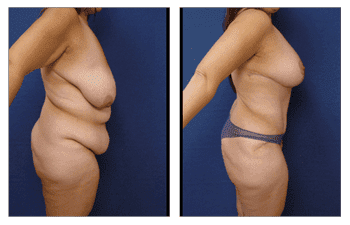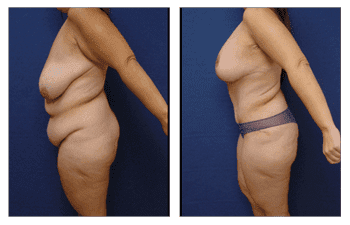
39-year-old body lift and breast lift with implant augmentation, full tummy tuck – right view

39-year-old body lift and breast lift with implant augmentation, full tummy tuck – left view

39-year-old body lift and breast lift with implant augmentation, full tummy tuck – right oblique view

39-year-old body lift and breast lift with implant augmentation, full tummy tuck – left oblique view

39-year-old body lift and breast lift with implant augmentation, full tummy tuck – front view

Download SurgiSculpt’s free Liposuction eBook
Introduction: Plastic Surgery After Weight Loss
Plastic surgery after weight loss is an ever-growing arena in the field of cosmetic surgery. According to the American Society for Metabolic and Bariatric Surgery, this past decade has seen a nearly 100% increase in weight-loss surgeries. Also referred to as bariatric surgeries, weight loss surgeries are an incredibly effective means of reducing significant volume of body fat. However, this surgery fails to address the side effect of excessive skin redundancy that is observed following weight loss. Weight loss results in not the number of but the volume of fat cells. Although weight loss dramatically improves a patient’s health, the accumulation of skin redundancy can pose another obstacle to patients achieving their full potential lifestyle improvements.
Plastic surgery after weight loss is dedicated to eliminating the skin redundancy that can become both a cosmetic and functional concern. Younger patients do maintain the capacity to automatically tighten their skin due to an intrinsic protein, called elastin, that resides in the skin. Unfortunately, patients older than 40 years of age, lose this beneficial protein; this results in the inability of the skin to self-tighten itself once the excess weight has been removed.
Regardless of age, the need to tighten the skin is real and becoming more prevalent as the number of weight loss surgeries expands. As such, plastic surgery to eliminate skin redundancy after weight loss has become increasingly popular as a final component of weight loss patients’ transformations.
Plastic Surgery after Weight Loss Ballance
Plastic surgery to eliminate skin redundancy after your weight-loss period requires a balance between skin redundancy and residual fat volumes. As a body contouring expert, SurgiSculpt surgeons pride themselves on achieving dramatic transformations through proprietary protocols, such as the High Definition Liposuction Body Scale, that optimizes balancing excess fat with skin redundancy.
This tool is utilized during your initial consultation to allow your surgeon to expertly define the degree of excess fat and skin redundancy to customize the most effective surgical plan. A post-weight loss plastic surgery case may include a combination of VASER liposuction, minimally invasive Renuvion skin tightening, and extensive surgical skin excisions all in the same operation.
Plastic Surgery after Weight Loss Case Study
Our patient presented for a total body lift that was combined with global liposuction to remove both redundant skin and excess fat. Removal of excess skin from her arms was completed using a brachioplasty procedure, from her breasts using a breast lift with implant augmentation, and from her abdomen with a full abdominoplasty. Her surgical plan was designed based on her score on the High Definition Liposuction Body Scale.
Choosing the right surgeon for your plastic surgery after weight loss is incredibly important for multiple reasons. First, you have dedicated significant effort to lose weight; the final elimination of skin redundancy and any residual fat is the final step to realizing your transformation.
The ability to complete your transformation requires a thorough appreciation of soft tissue anatomy as well as precise surgical planning. Second, plastic surgery after weight loss will most likely include extensive surgical incision lines. As such, it is important to choose a surgeon who possesses expertise in the repair of incision lines and experience with optimal incision line healing.
Conclusion: Plastic Surgery after Weight Loss
If you are interested in how plastic surgery can help you after significant weight loss, set up your consultation to complete your own customized HDL Body Scale assessment with a SurgiSculpt surgeon today.
After weight loss surgery, our 39-year-old female patient completed her total body lift and global liposuction that included brachioplasty, breast lift with implant augmentation, and a full tummy tuck.
After weight loss woman of 39-year-old status posts total body lift including Brachioplasty, breast lift with implant augmentation, full tummy tuck.
